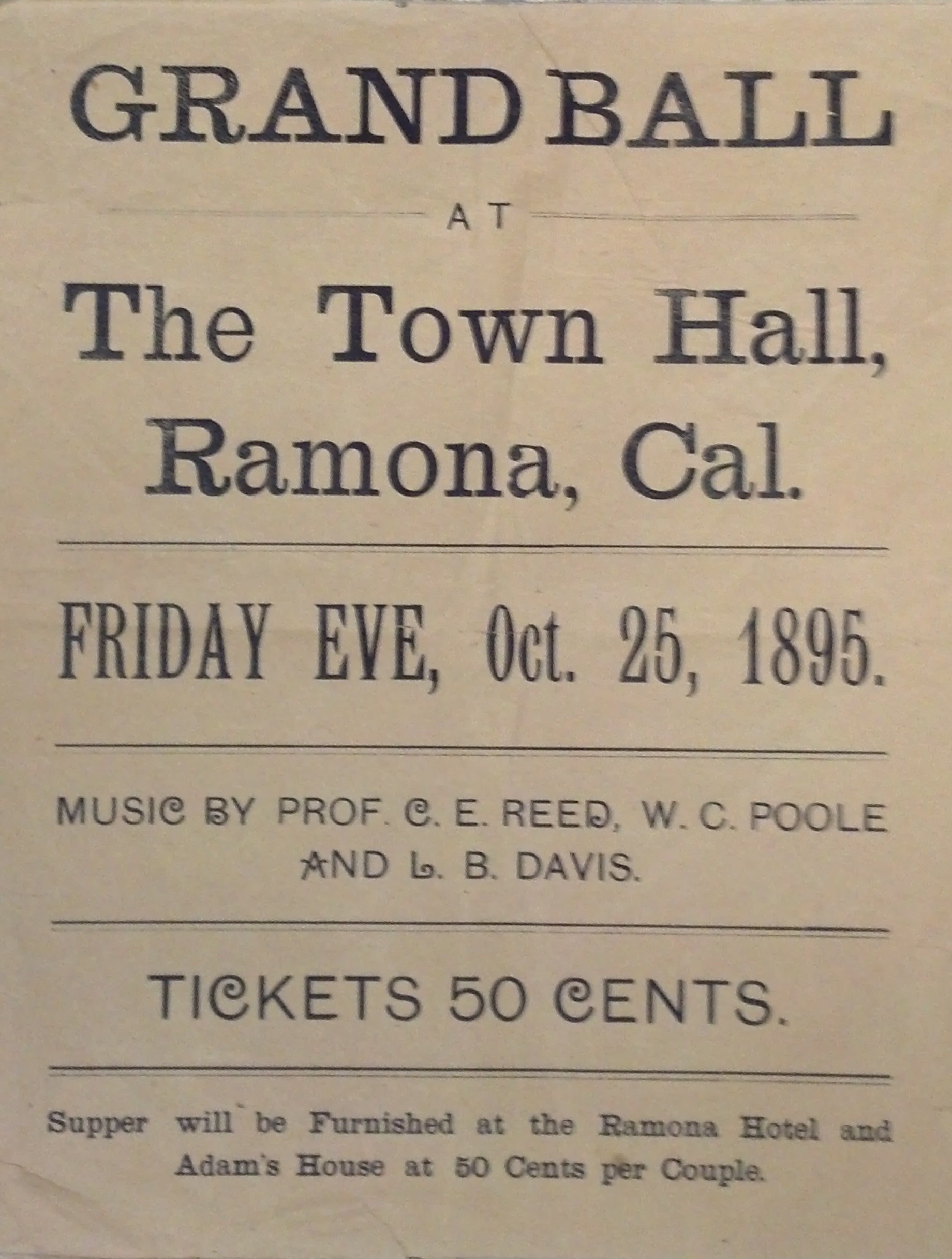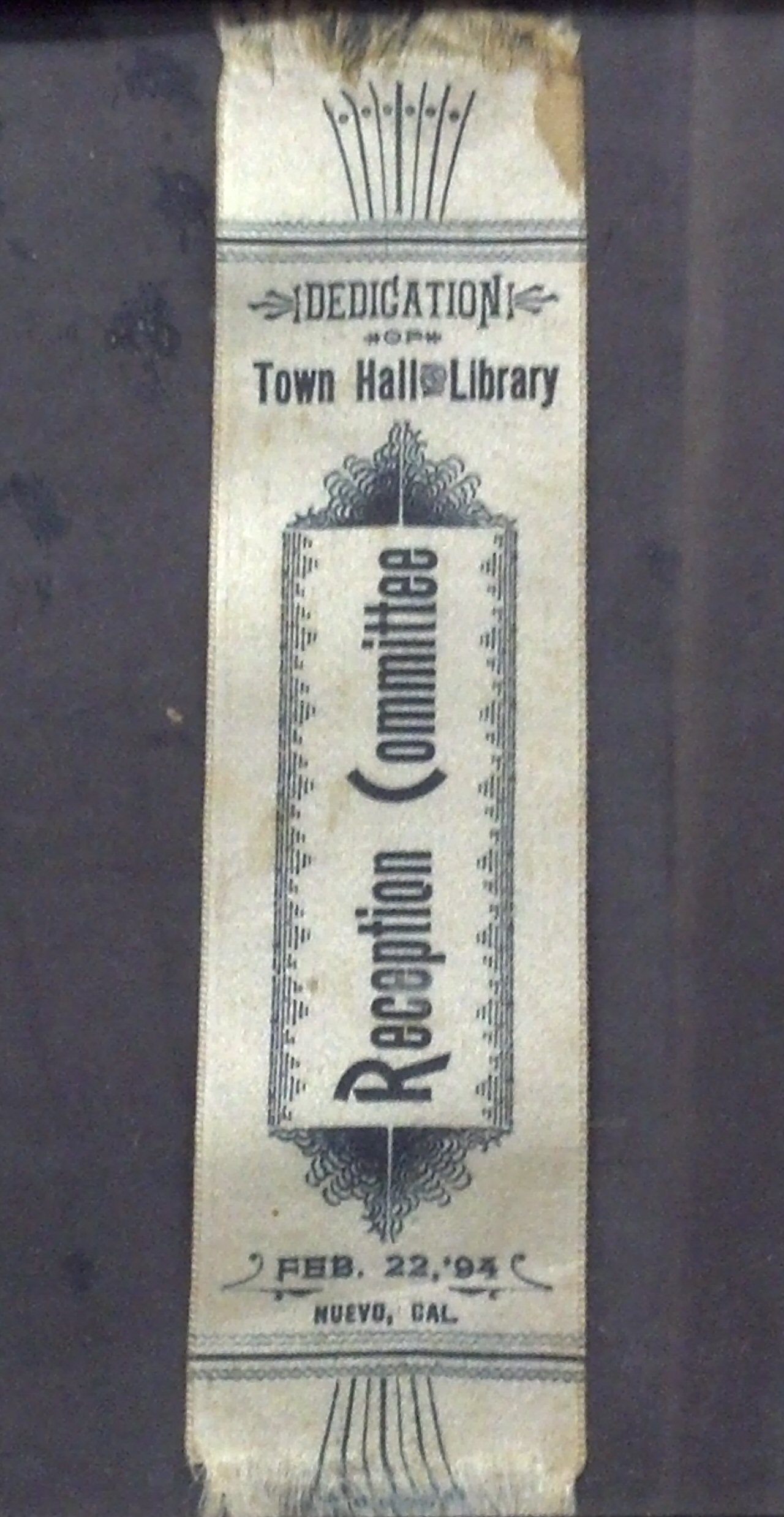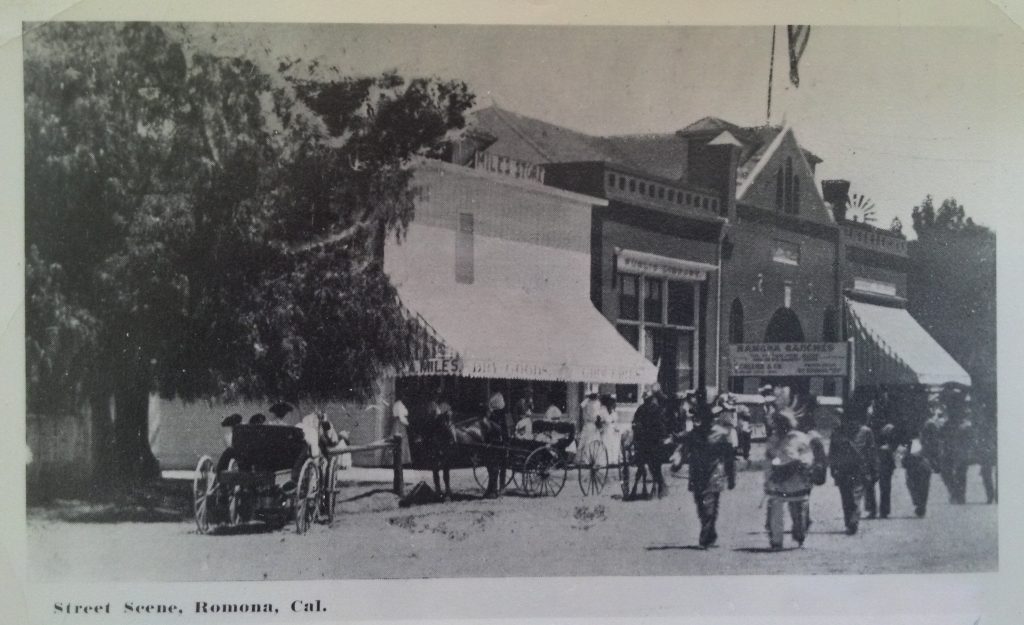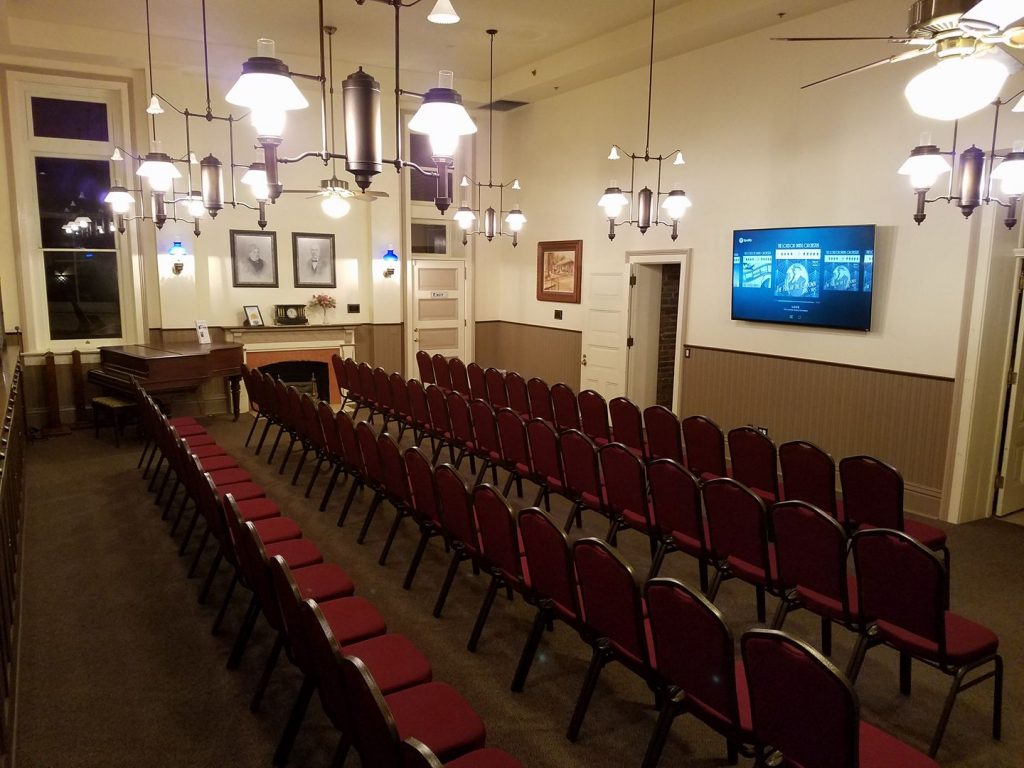Latest From the Blog
Archive Item: October 1977 Factual Report of the Ramona Town Hall
The following is a factual report regarding the use and purpose of the Ramona Town Hall and the changes it has undergone since its inception.
According to the original record book of the Ramona Town Hall dated February 19, 1894, Augustus and Martha Barnett, husband and wife, of the County of San Diego, State of California for a good and valuable consideration perceived, do grant to Irving F. Winnick, George A. Telford, Thomas Jerman, Jeff A. Verlaque and Edward C. Foreman as trustees of an unincorporated association, known as the Town Hall of Nuevo and to their and each of their successors in interest as hereafter provided.
The following described real property, situated in the County of San Diego, State of California, particularly described as Lots Seventeen and Eighteen, Block 40 in the town of Ramona, as per the official map on file in the office of the County Recorder of San Diego County, in Trust for the following named uses and purpose to wit: All of said property and the building situated thereon to be held , used, rented and the business pertaining thereto, to be forever conducted for the general benefit of the residents of the town of Nuevo and all the country now embraced in the Santa Maria Judicial Township. That a public hall in the building thereon shall be for the use of the public, under the direction and control of said Trustees but upon equal terms and conditions to all and every person, persons or corporations desiring to use the same for public meetings, whether religious, political, social, theatrical, operatic, or literary without preference to sect of party, except in this: The said Trustees shall have the right to fix the rent to be charged for the use of said building for the various purposes aforesaid, making such regulations and distinctions between said uses and purposes as they may deem proper but the charges fixed for each of the uses aforesaid shall be uniform in each separate case. That a public Library shall be kept and maintained upon said premises in which a selection of books and literature shall be kept and used without preference given to any religious sect or denomination, political party or and religious or literary thought, excepting, only that all vulgar, obscene or other literature demolishing in its effects, shall not be allowed or kept therein.
That the aforesaid Trustees shall rent, lease or permit to be used said property and all improvements thereon from time to time as they may deem proper and for a reasonable consideration and shall apply the net proceeds arising therefrom to the named purposes to wit:
1. To the payment of all taxes and assessments lawfully laid, assessed or levied upon or against the same or any part thereof.
2. To keep said property insured, also in good order and repair.
3. To pay for books and other literature necessary for said library and the expenses necessary incurred in taking care of them.
As of record in the original book of the Town Hall minutes up and including the year 1958 there had been a total of 30 people who had served as board members. The first board members appointed by Mr. Barnett were Irving F. Winnick, George A. Telford, Thomas Jerman, Jeff Verlaque and Edward C. Foreman, all who were appointed February 22, 1894.
Thomas Jerman served the longest time on the board. He passed away February 7th, 1920. He owned what is now the Rexall Drug Store at 7th and Main Street, known at that time as “Jermans Drug Store” which had within its confines, drugs, hardware, soda fountain, horse collars and other items used by ranchers.
The first meeting of the board of Trustees was held on February 26, 1894. the first order of business was to elect their officers as follows:
President: J.F. Winnick
Vice President: Thomas Jerman
Secretary: E.C. Foreman
Treasurer: J.A. Verlaque
Trustee: Geo. Telford
A committee was formed to write a set of Bylaws and set up a Library. $2,500 was decided upon. Insurance $2.04 per year. $2.00 per week was decided to charge for a dancing school that was to be established. The following month it was decided to hire a janitor for $5.00 per month. Duties included policing the dances, sweep all the buildings, keep dust out of the windows, stay till all performances were over and put out the lights.
Dr. Halbar was appointed Librarian and for his pay he would receive free rent for his office on the west side of the main hall entrance.
On August 27, 1894 a piano was purchased for $200.00 from Mrs. Pierce.
January 15, 1895–Three churches wanted to rent the Hall. The Town Hall Board had to divide their time equally. The rent to be paid in advance at $1.10 per Sunday and to be paid promptly. The Library was set up and books and magazines were ordered which totaled 17 in all.
February 22, 1895 — The first annual meeting was held, open to the public with 20 Townspeople attending.
Total cash received —————$581.85
Warrants Drawn by Treasurer –$509.60
Cash on hand ———————–$72.25
March 1, 1895 –The upper part of the Town Hall was leased to the High School for two years. A total of 20 students were in attendance. No price was reflected in the minutes of the board.
July 17, 1896 –James A. Jasper, publisher of the Sentinel newspaper, is appointed by unanimous vote to replace Trustee Edward C. Foreman, (removed from Ramona.) The Foresters Lodge rented upstairs room for $1.00 for each meeting night, including chairs but furnished their own lights.
February 27, 1897 –A new Librarian and Janitor was hired for $15.00 per month.
March 29, 1897 –Rent was set at 35% of door receipts if they didn’t want to pay regular price of $5.00 per night.
March 29, 1897 –Room on east side of building was reduced from $200.00 per year to $120.00 per year which was a general store.
November 16, 1897 –Librarian and Janitor discontinued for lack of funds.
April 29, 1899 –The following rates were adopted for the rent of the hall, until midnight $3.00 — All night $5.00 — These rates were to be charged when an admission was charged at the door. When educational or other entertainments with no admission charged, the rental was to be $1.50 for the evening and $1.00 for day time use. All political meetings till midnight $5.00, if dance afterwards $2.50 extra. Store room and supplies for lunch $2.50 extra. Dances given by Trustees $5.00 and no exceptions.
January 6, 1901 –A Barber Shop and Fountain was to open next to the Library by Robert Green, and pay 20% of his receipts to the Library.
March 30, 1901 –A resolution passed, anytime a member absents himself from 3 of our regular meetings without just cause, he shall be asked to resign, at which time the meetings were changed from 4 o’clock to 3 o’clock P.M. on the last Saturday of each month.
April 27, 1901 –Library was calcimined and woodwork was varnished.
August 31, 1901 –Moved the monthly meetings be done away with and yearly meetings be held hereafter, only by special call for meeting otherwise. Barber Shop rented for $1.50 in West Office room.
February 24, 1903 –West room was rented for $75.00 per year for Barber Shop, Second Hand Store, Wall Paper and Cigar Stand.
1903 –Two large gasoline lamps were purchased for $25.00 to light the hall.
August 20, 1904 –The Board took up the matter to have the property of the Town Hall transferred to a Library Association to be formed and incorporated.
August 5, 1905 –Congregational Church rented room for $6.25 for Church.
February 23, 1906 –Rent changed from $5.00 to $10.00 for all night dances.
November 16, 1906 –O. Rilly made a proposition to Town Hall Board to lay a side walk in front of Town Hall for 20¢ sq. ft. and 60¢ ft. for curb. Motion carried for cost of $276.00
February 23, 1907 –It was decided only one practice be allowed before each entertainment.
February 24, 1909 –Office rent for room next to Library raised from $2.00 to $3.50 per month. Voted to buy chemicals for the two wheeled fire engine and build a shed for it on the east side of the hall.
Nothing of interest was noted between 1909 and 1917. Just opened and closed the meetings.
February 26, 1917 –A Mr. Cuming offered to rent upstairs for $50.00 per year paid in advance if the stairwell and upstairs was put in safe condition. All materials furnished by Town Hall Board and work to be done by the Lodge.
November 18, 1920 –Special Meeting. A Rest Room was built next to the Library.
March 3, 1922 –Ms. Amy Strong is the first woman appointed to the Town Hall Board.
March 12, 1925 –Southern Electrical Company was paid $200.00 and a balance of $219.15 later to hook up to their services.
April 22, 1927 –Special Meeting. $675.00 spent to put a new roof on Town Hall.
January 30, 1929 –A #1 Maple floor to be installed at a cost of $130.00 per thousand feet. $65.00 to go for sanding. Work donated to lay the floor by American Legion Boys Post #332. Also tinting and calcimining.
March 8, 1929 –$500.00 borrowed to liquidate the indebtedness of floor cost.
January 28, 1930 –Special Meeting. Granting American Legion Post permission to install basketball court.
March 25, 1937 –$300 borrowed to repair roof and front of east wing of Town Hall.
June 3, 1945 –A new roof for entire hall installed by Standard Roofing Company of San Diego for $1332.00
February 15, 1948 –Justice Court and Sheriffs Office to pay 65¢ per sq. ft. for the east wing of Town Hall.
April 9, 1948 — Final details on the remodeling of Town Hall. Bruce Telford was hired as foreman.
August 16, 1948 –$2000.00 borrowed from Bank of America, at the same time 100 folding chairs were purchased. This was to cover wages to be paid for repair work. Wages came to $1,825.75 – Material was $3,062.73.
October 1, 1948 –The Gala Town Hall opening took place with 401 local residents attending, taking in a grand total of donations of $1016.00.
July 26, 1949 –It was moved and seconded, each Board member loan $100.00 to the Town Hall fund to finish paying off loan at the bank.
November 18, 1951 –New swinging doors install in Town Hall at a cost of $200.00.
October 21, 1958 –The Ramona Town Hall at this time was in good repair and free of indebtedness. The present board had served for several years and thought it should step out and install a new Town Hall Board of Trustees. Mrs. Garnett Eller is the second woman appointed to the Town Hall Board.
December 1, 1958 –Teen age club known as the Bulldog Club, took over old Library room. Barnetts suggested a historical museum be installed within the building.
September 21, 1961 –Town Hall declared to be free of taxes.
1962-1963 –A total of $1236.87 was spent on the refinishing of the floor in the Town Hall.
January 24, 1963 –The Town Hall was painted.
November 1965 –A new roof was installed at a cost of $1,717.06.
January 1966 –A propane heater was installed in the teen center room for $75.00.
October 22, 1968 –Set of bylaws adopted and approved by County tax assessors office as meeting the requirements for tax exemption.
November 1969 –Palomar Branch of Y.M.C.A. takes over by quitclaim deed to the Ramona Town Hall.
1969 to 1976 –The Y.M.C.A. had control of the Town Hall, at which time it became in a run down condition. After much work on the part of the present Board, it was brought back under control of the local people and was incorporated. At the present time the Town Hall is being used by the Teen Center in the west wing. The Art Loft, a group of local artists have the east wing. The Chamber of Commerce occupies the east office room. The Community Theatrical groupe is using the main hall. The Ramona Pioneer Historical Society will be using the main hall for its regular meetings.
For the eighty three years the Town Hall has been in operation, there has been more than two dozen different types of enterprises conducted within its confines.
The grand old building is now in the process of undergoing a general overhaul of the electrical system, plumbing, painting inside and out. Installation of security measures to the doors, windows and a wrought iron gate in the main entrance. All possible from a grant obtained from the Comprehensive Employment Training Act for the sum of $45,000.00. At the present time, (October 1977,) the following are members of the Board of Trustees:
President: John Stevenson
Vice Pres: Robert Pike
Secretary: Arvie Degenfelder
Treasurer: Robert Shumate
Trustee: Ward Oden
Trustee: Guy Woodward
Trustee: Ruth O’Leary
West Wing Monitor
THE STORY OF THE RAMONA TOWN HALL
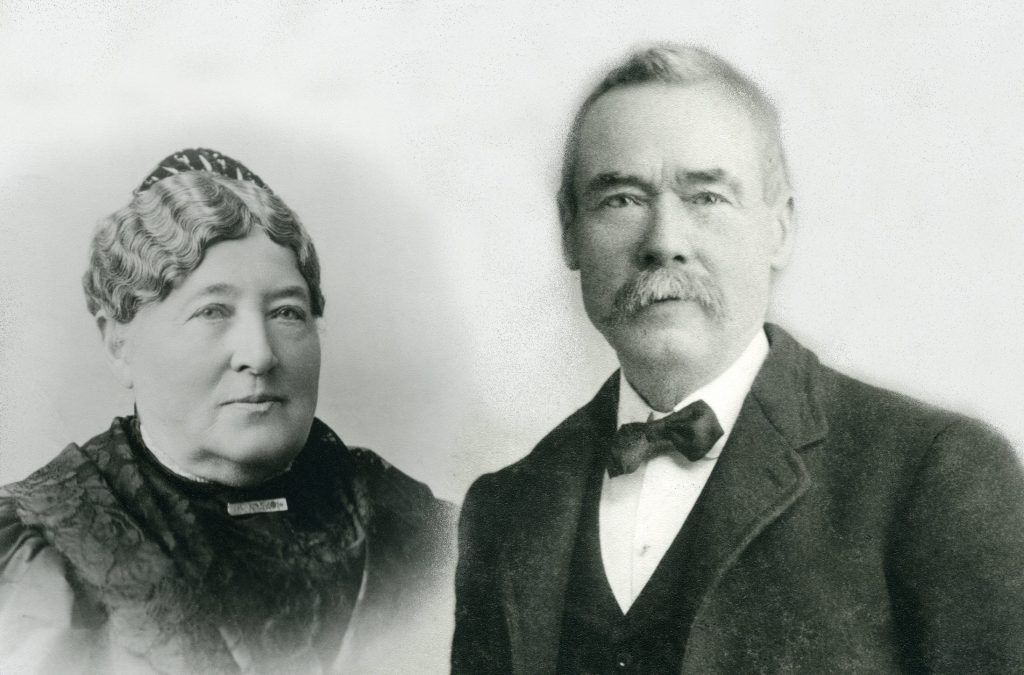
Original Benefactors, Martha and Augustus Barnett
“As the story goes, Augustus thought it improper for dances to carry on all night at the school house, and that the growing town needed a place to serve that purpose as well as a library.”The Ramona Town Hall was donated to the town people of what was then Nuevo on Washington’s Birthday, February 22, 1894, by Augustus and Martha Barnett. Construction on the two story edifice began on July 11, 1893 on two lots donated by realtor Milton Santee, and was completed in February 1894 at a cost of $17,000. (Later that year, at the insistence of Mr. Santee, the town was renamed Ramona, to capitalize on the popularity of the fictional character from the best seller by Helen Hunt Jackson.) The Barnett’s established an unpaid five member board of trustees in perpetuity to administer the operation and upkeep of the Town Hall. For the past 123 years, the Ramona Town Hall has operated solely on private donations, fundraisers, grant moneys, and rent collected for use of the building. The Ramona Town Hall is not owned by the Town Hall Board of Trustees, nor is it a public agency. The restoration work that has taken place in the past 30 years has been funded by county administered C.D.B.G. and P.L.D.O. funds, along with private donations and the fundraising efforts of the board of trustees and honorary mayor. The work completed to date includes a complete seismic retrofit of the entire front portion of the building, installation of new plumbing and electric wiring in the east and west wings, three new restrooms, a new roof over the entire building, façade replacement, and fire sprinklers throughout the entire building.
Important Facts:
The California Landmarks Advisory Committee approved the Ramona Town Hall as a Point of Historic Interest on January 26, 1973.
The San Diego County Board of Supervisors designated the Ramona Town Hall as a Historic Landmark on November 10, 1991.
The Ramona Town Hall celebrated its 100th Anniversary on February 22, 1994.
The “Save our Heritage Organization” presented the Ramona Town Hall Board of Trustees with the prestigious “Civic Restoration Award” on May 10, 1994, the Centennial Year of the completion of the Town Hall.
The Ramona Town Hall was placed on the National Register of Historic Places on September 26, 1994.
The John P. Squibob Chapter 1853 of E Clampus Vitas dedicated a historic marker plaque for the Ramona Town Hall on April 25th, 2009 (The Chapter also presented a plaque that recognizes the Ramona Town Hall’s place on the National Register of Historic Places.
The 123 year old Town Hall is one of the oldest and last original Town Halls in California, and is registered as a State Historic Landmark.
The Ramona Town Hall is one of the largest and oldest adobe structures in the entire Southwest, and features an Romanesque/Mission Revival architecture, a style unique to its architect, William Sterling Hebbard, (1863-1930.)
